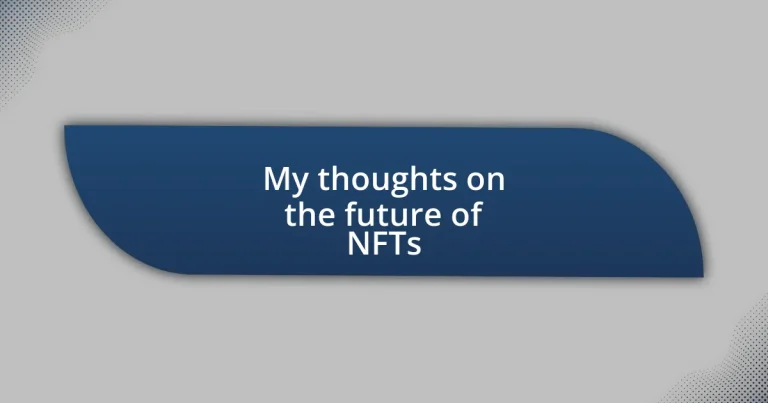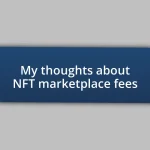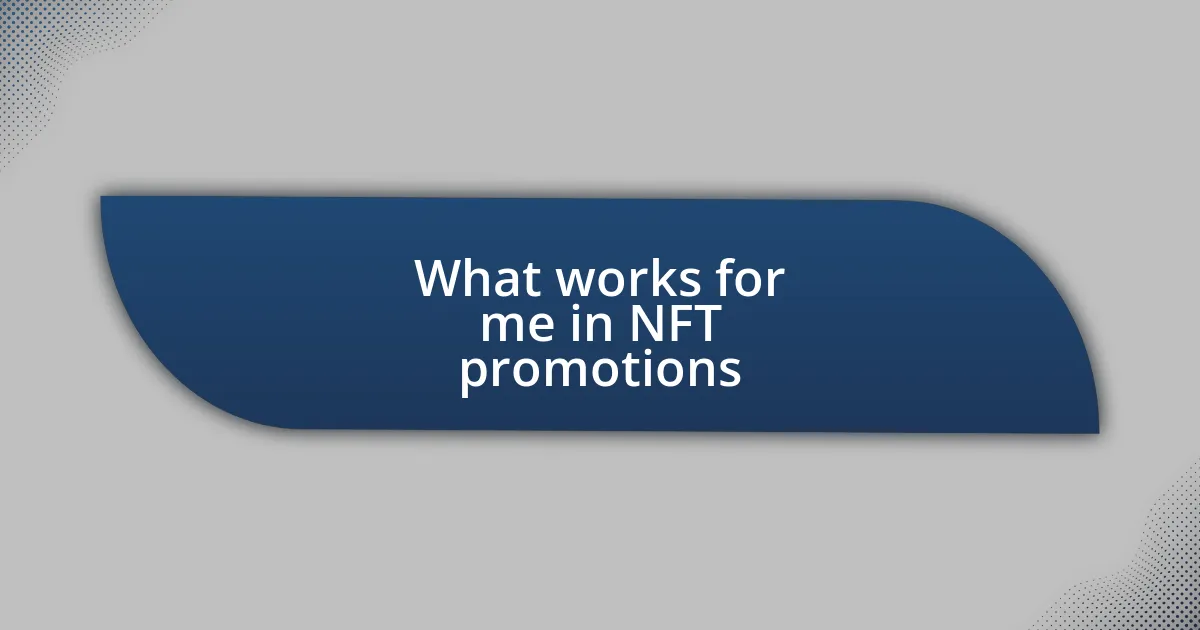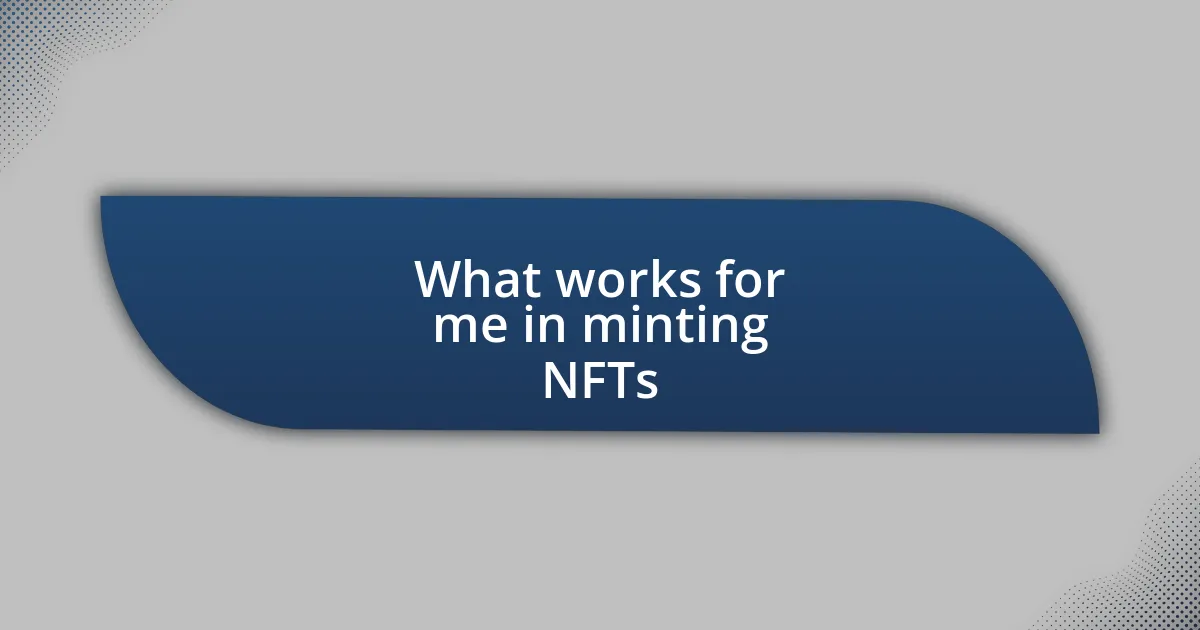Key takeaways:
- NFTs offer unique ownership of digital assets, revolutionizing how creators monetize their work and connect with audiences.
- Current trends include utility-based NFTs, fractional ownership, eco-friendly platforms, community-driven projects, and integration with gaming.
- Challenges for NFT adoption involve complex technology, environmental concerns, and market volatility affecting investor confidence.
- The future of NFTs may lead to enhanced integration in digital experiences and gaming, fostering sustainable profit models for creators and deeper consumer engagement.
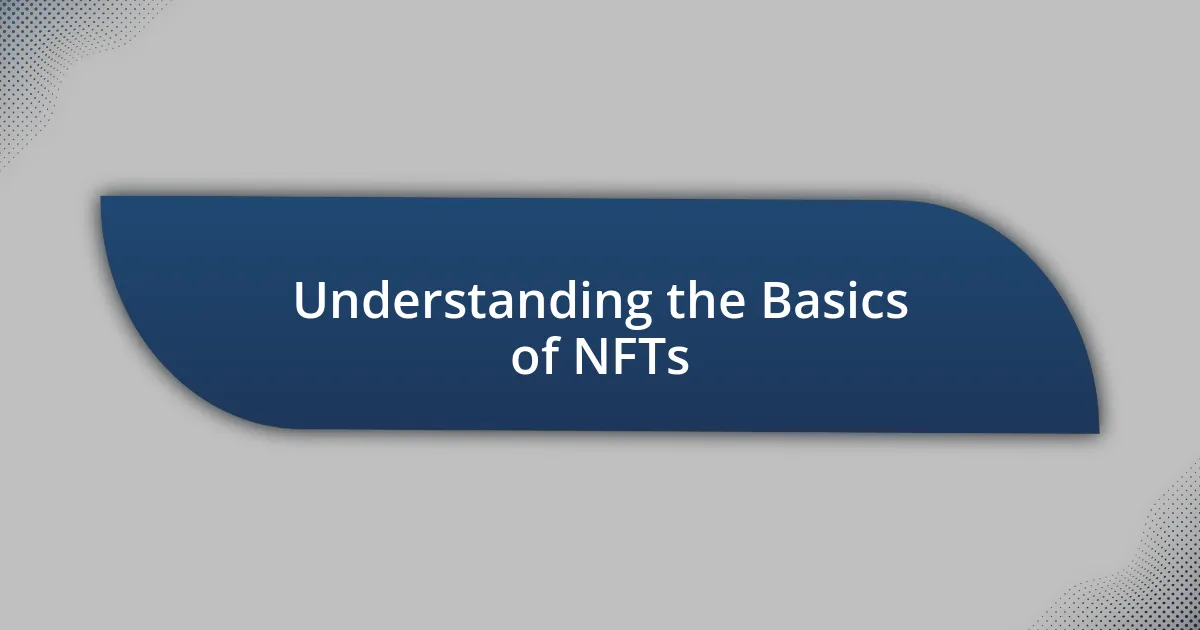
Understanding the Basics of NFTs
NFTs, or Non-Fungible Tokens, are unique digital assets that represent ownership or proof of authenticity for a specific item, often linked to art, music, or collectibles. This uniqueness is what sets NFTs apart from cryptocurrencies like Bitcoin, which are fungible and can be exchanged for one another. I remember the first time I saw an NFT marketplace; it felt like stepping into a parallel universe where digital creations held tangible value.
Owning an NFT is like having a limited edition of a favorite piece of art hanging on your wall; there’s a sense of pride and ownership that’s hard to replicate. But what makes these digital tokens captivating is their potential for creativity and storytelling. Have you ever considered how a meme, once just a fleeting moment online, can now be immortalized with an NFT? It’s this transformative power that inspires many artists and creators to explore new avenues through blockchain technology.
Understanding how NFTs work on the blockchain is crucial, as this technology provides the security and transparency needed to verify ownership. Each transaction is recorded, creating a traceable history that distinguishes an original work from copies. Personally, diving into the intricacies of blockchain was like peeling back layers to uncover a treasure trove of information that reshaped my understanding of digital ownership.

Current Trends in NFT Market
Current Trends in NFT Market
The NFT market is evolving rapidly, with several key trends shaping its direction. I find it fascinating to observe how brands and celebrities are increasingly jumping on the NFT bandwagon, creating unique experiences that engage their fans. For instance, mainstream artists are now selling exclusive music tracks as NFTs, offering a new revenue stream while deepening the connection with their audience.
Here are some notable trends currently influencing the NFT landscape:
- Utility-based NFTs: Many creators are focusing on adding real-world benefits to their NFTs, such as access to exclusive events or services.
- Fractional Ownership: This allows multiple users to own a share of high-value NFTs, democratizing access to premium assets.
- Environmental Concerns: As awareness of the ecological impact of blockchain increases, there’s a growing demand for sustainable NFT platforms, prompting creators to seek eco-friendly alternatives.
- Community-Driven Projects: More NFTs are being developed within community frameworks, emphasizing collective ownership and value growth.
- Integration with Gaming: The blending of NFTs with video games is on the rise, allowing players to truly own in-game assets, a shift I believe brings an exciting dimension to both gaming and digital asset ownership.
Watching these trends unfold feels like being part of a digital revolution. It’s invigorating to know that the future holds a profound shift in how we perceive ownership, not just in art, but in various facets of life.
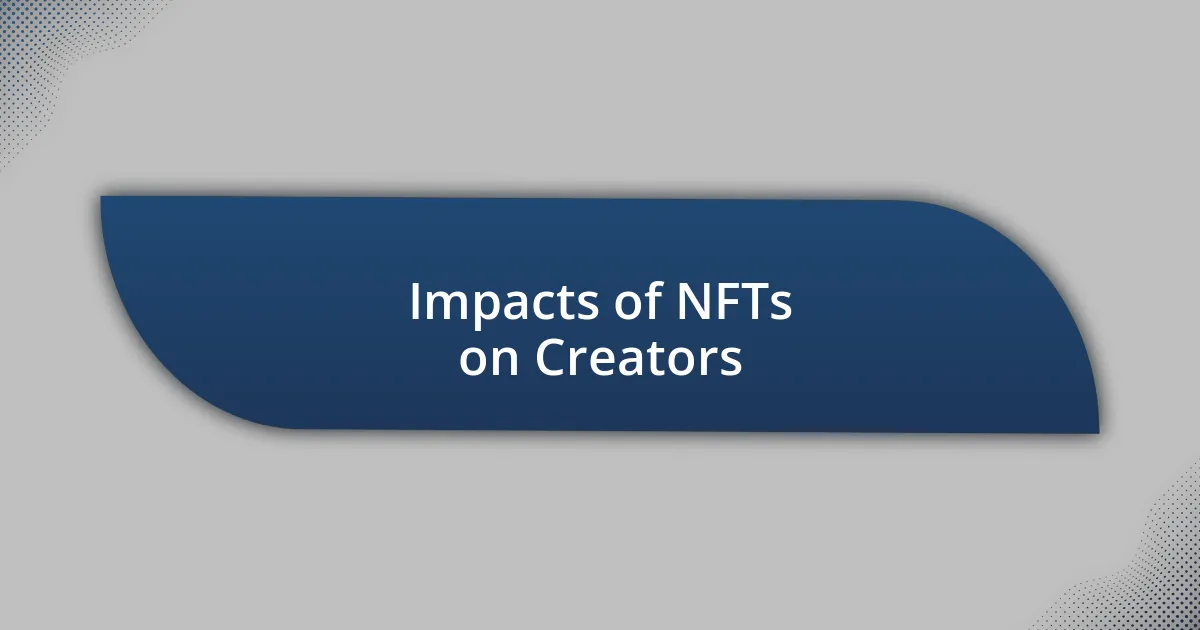
Impacts of NFTs on Creators
The rise of NFTs has significantly impacted creators, offering them unprecedented avenues for monetization. I remember chatting with a digital artist who was struggling to get her work noticed. After minting her art as NFTs, she not only gained recognition but also began earning far beyond the traditional commission-based model. It’s empowering to see how NFTs can transform an artist’s journey from obscurity to financial stability.
On the other side, there’s the emotional rollercoaster that comes with owning an NFT. Many creators express a deep sense of pride when they sell their digital art as NFTs. It validates their skills and creativity in a space that often lacks appreciation for digital work. However, the volatile nature of the NFT market can lead to anxiety as creators watch their art’s value fluctuate over time, often questioning their worth in an unpredictable ecosystem.
Looking at the broader picture, NFTs can help level the playing field for creators everywhere. I’ve observed independent musicians leveraging NFTs to fund their projects, bypassing traditional music labels altogether. This not only increases their profits but also allows them to maintain creative control. In an age where creators are often exploited, I find it refreshing to witness their empowerment through this new technology.
| Positive Impacts | Challenges |
|---|---|
| New revenue streams for artists | Market volatility leading to uncertainty |
| Enhanced connection with audiences | Potential for copyright issues |
| Empowerment through creative control | Pressure to constantly innovate |

NFTs in the Gaming Industry
NFTs are quickly gaining traction in the gaming industry, transforming how players interact with their favorite titles. I recently spoke to a game developer who is integrating NFTs into his next project. He mentioned that players can actually own unique in-game assets, such as skins or weapons, giving them a sense of ownership that wasn’t possible before. Doesn’t it feel rewarding to invest time in a game and truly own a piece of it?
The appeal of NFTs in gaming doesn’t just stop at ownership; they offer players opportunities for real-world profits. Imagine playing a game where you can sell your rare collectible items on a marketplace. I know a gamer who turned a hobby into a side income by trading NFTs from his favorite games. Just thinking about it raises an exciting question: Could gaming soon become a legitimate avenue for financial growth?
Moreover, integrating NFTs can stimulate community engagement in groundbreaking ways. I find it fascinating how games are starting to incorporate player votes on developments or expansions through NFT ownership. This kind of model fosters a deeper connection between developers and gamers. It makes me wonder, are we on the brink of a gaming revolution where players have a direct say in their gaming experiences?

Challenges Facing NFT Adoption
The journey toward widespread NFT adoption is certainly not without its hurdles. One major challenge I’ve noticed involves the complexity of blockchain technology. Many potential users feel overwhelmed by the technical jargon and processes required to buy, sell, or create NFTs. It reminds me of my early days in cryptocurrency when I struggled to navigate wallets and exchanges. How can we expect mainstream audiences to embrace NFTs if they find the entry barrier so high?
Another obstacle is the skepticism surrounding the environmental impact of blockchain networks. As discussions about climate change intensify, I find myself pondering how the NFT community can address these concerns. For example, more eco-friendly solutions like proof-of-stake networks are emerging, but convincing creators and collectors to shift can be tricky. Will the market prioritize environmental sustainability over mere profit?
Lastly, the volatile nature of the NFT market poses significant risks for investors. I recall a friend who invested heavily in NFTs, only to watch their value plummet overnight. This kind of unpredictability can deter potential newcomers who are wary of financial loss. How do we balance the exciting potential of NFTs with the need for a more stable and reliable market?
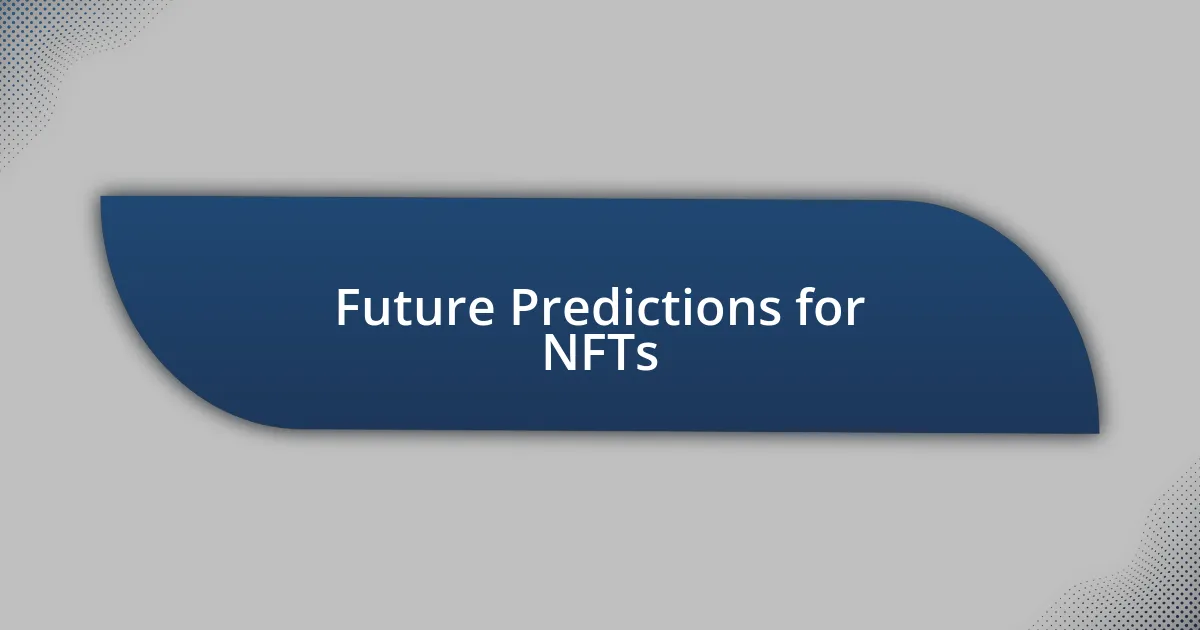
Future Predictions for NFTs
As I look ahead, I foresee NFTs becoming more integrated into our everyday digital experiences. I believe this will not only change the way we perceive ownership but also redefine how we interact with online content. For instance, imagine a scenario where artists and creators can effortlessly retain a portion of the profits every time their work is resold. Wouldn’t that create a more sustainable model for creatives?
Additionally, I can’t shake the feeling that NFTs will play a significant role in the gaming industry. From my own experiences as a gamer, I’ve often wished for a way to truly own in-game assets. In the future, I envision a landscape where gamers can buy, sell, and trade their assets freely, making each achievement more meaningful. How revolutionary would it be if the time and effort we invest in games could translate into real-world value?
Moreover, I suspect we’ll soon see a shift toward mainstream brands adopting NFTs as a form of engagement and loyalty reward. Think about it: major companies have always sought innovative ways to connect with their customers. I wouldn’t be surprised if we start seeing NFT-based memberships or exclusive access to products just for holding a particular NFT. Isn’t it exciting to think about the possibilities that lie ahead for both consumers and brands in this evolving space?

